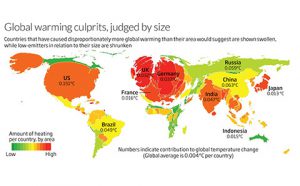It came as little surprise when Beijing’s environmental authorities reported in early January last year that the capital’s levels of PM2.5 (a measure of air pollution) were more than double the national standard. The past year saw no end to the smog; nor did 2013 see an end to the litany of environmental disasters around China – from the thousands of dead hogs that floated down the Huangpu River in Shanghai, to the covered-up toxic spill in Hebei province.
What’s more, China’s top economic planner, the National Development and Reform Commission, said in December that the country is falling short on key goals under its 12th Five Year Plan. By 2015, China aims to cut the energy intensity of its economy (energy consumed per unit of GDP) by 16% and its carbon intensity by 17%, but so far it has only achieved a drop of around 6% on either. For now, the strategy of GDP growth at all costs has the upper hand.
In the international environmental arena, climate change will be at centre-stage this year, as negotiators prepare for key UN-led climate talks in Paris in 2015. The size of China’s economy is such that any conversation about a global deal on climate change that fails to include it is meaningless.
So, on first glance, the environmental forecast for the new year – China’s Year of the Horse – looks distinctly gloomy. But might that overlook the country’s potential for path-breaking green innovation?
Meaningful action to mitigate climate change will mean a complete departure from business-as-usual: huge transformations in the ways we power and heat our homes; in the ways we travel; and in the ways we feed the planet’s growing population. The history of previous such transitions, such as the information and communication technology revolution, suggest the need for aggressive and sustained state support for new technologies.
While many western countries have downgraded or abandoned their support for such a transition – the British chancellor made clear he does not want the UK to be at the forefront of tackling climate change; Australia is scrapping its environmental policies; Norway has abandoned its development of carbon-capture technologies; Spain has ceased its strong support for renewables; Canada is even dismantling scientific institutions; and climate-change policies face an uphill struggle in the United States – China’s 12th Five Year Plan pledges huge investments and strategic support for clean energy vehicles, new energy, next-generation agricultural technologies and more (read more about the plan here).
Significantly, China has also for the first time overtaken Europe on the share of its economy devoted to research and development, the Organisation for Economic Co-operation and Development (OECD) will report this month. In 2012, it invested 1.98% of its GDP into R&D, compared to 1.96% for the 28 member states of the European Union (EU).
There are reasons for caution: in September 2013, it emerged that only five solar-power vendors remained in a space built for 170, called ambitiously “Silicon Xinyu,” in Xinyu, Jiangxi province. In March, China’s once-fêted solar-panel manufacturer Suntech Power began bankruptcy proceedings.
But the larger picture is more promising: despite the setbacks, China has continued to support the growth of its domestic solar market – in 2013, it committed to quadrupling its solar generation capacity, raising its 2015 installation target to 35 gigawatts. Companies like Trina Solar seem to be growing healthily. Influential analysts HSBC Global Research have predicted the further expansion of clean tech in 2014, with solar “dominated by China and Asia,” in what it billed “the year of reconnect” on climate change.
Similarly, while China’s centrally driven efforts to support electric vehicles haven’t always gone to plan, the country’s cities have seen the emergence of a disruptive low-carbon innovation in the form of electric bicycles.
Furthermore, often overlooked in public debates around climate change is the importance of agriculture: not only is food security inextricable from concerns around the effects of climate-change on water and energy, but also the manufacture and use of synthetic nitrogen fertiliser is estimated to account for some 9% to 15% of China’s emissions. Again, China’s core state support for new, lower-carbon approaches to farming – which would use land more efficiently or save energy through innovation – could be game-changing.
Breakthroughs towards a green industrial revolution would not only affect technology and markets around the world, but also affect the ways we live, travel and eat: they are social phenomena, which require careful attention. Recognising this, a new, international research project, launched on Tuesday, “Low Carbon Innovation in China: Prospects, Politics and Practice” aims to understand how low-carbon innovation is emerging in China, and what its progress might tell us about the transition to a more climate-resilient society in China – and the rest of the world.
This new project – on which I am a Research Fellow, and chinadialogue is a media partner – is funded by the Economic and Social Research Council (ESRC) and led from Lancaster University in the UK, with investigators and researchers from University of Sussex, the School of Oriental and African Studies, Tsinghua University and the Centre for Chinese Agricultural Policy. It will run until 2016, and aims to understand how different models of innovation have fared in transforming China’s energy, agriculture and mobility sectors for a lower carbon future.
There are a number of complex issues here, which we’ll be discussing in more detail at chinadialogue over the coming two years, but some key questions will include:
• How have high-tech, IP-intensive and centrally-managed approaches to low-carbon innovation in China differed from more “grassroots” and open-source efforts?
• Can studying the practices of Chinese users of new, low-carbon technologies provide a different, more informed picture about what, how and why particular low-carbon innovations are succeeding or failing?
• How do these successes and failures interact with changes in the power structure in China, both domestically and internationally?
• What lessons might these questions contain for approaches to low-carbon innovation and green industrial policy in the rest of the world?
The answers to these questions – and whether such emerging low-carbon approaches portend a healthier environment for the Year of the Horse – remain to be seen, but in the run-up to a crucial year for climate change, China’s progress on low-carbon innovation matters now more than ever.







